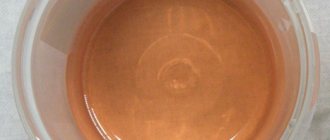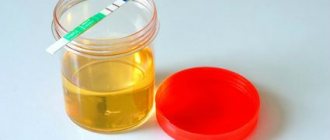As a rule, changes in a person’s health status are reflected in the functioning of all organ systems, including the kidneys and the urinary system as a whole. That is why changes in a person’s health can be judged by the color of urine and its changes.
Sometimes parents notice that the child’s urine has become colorless, similar to water, and a natural question arises: does this indicate the occurrence of serious health problems?
What color should a healthy child's urine be?
Initially, it is necessary to understand what color the child’s urine should be normally. Experts say that the color of urine in a healthy child should be yellow. Also, depending on individual indicators, the shade may change: from light to dark and saturated.
The color of urine depends on the amount of pigments, they are also called urochromes. If there are a lot of pigments in your child's urine, this means that it will have a dark color.
It should also be said that a change in the color of urine in the morning is absolutely normal, since at this moment a large amount of pigments is concentrated in the child’s urine. That is, the urine after the night should be dark, this is normal.
What affects the change in urine pigment?
The composition of urine indicates the metabolism occurring in the body. If it is very active, the color and smell will be pronounced. Physical activity and increased stress affect the metabolic process and put additional stress on the kidneys.
There is such a substance - bilirubin. This is a pigment. It turns urine yellow. Bilirubin is formed due to the breakdown of red blood cells. The metabolism of bilirubin is associated with the functioning of many systems and organs, which is why urine analysis is so often used in diagnosis. When organ functions are disrupted, more substances enter the biological fluid, which affects the color of urine - from bright yellow to deep brown.
The levels of bilirubin in urine differ in people of different ages. In newborns, increased levels of the substance are considered normal. This is due to adaptation to new conditions. The so-called jaundice of newborns usually goes away on its own, without additional intervention.
In infants up to one month old, the normal concentration of the substance is from 2 to 20 µmol per liter. Over one month, the indicator changes - from 3 to 20 µmol per liter. In older children, the norm is considered to be a concentration from 3.4 to 17.1. If the levels are elevated, additional tests are taken, including a blood test. It is important to pay attention to the collection of analysis and its storage. It is necessary to exclude the possibility of foreign substances entering the container. To do this, wash the child well and take a sterile jar.
- Poor urine test in a baby
Watch the video film “A child’s urine is like water”:
Diabetes can also cause these changes in urine color. In this case, the change in the color of the child’s urine will be provoked by the body’s attempt to remove excess glucose from the body using the urinary system. In this case, the child will drink a lot of water and go to the toilet often.
Kidney failure is also a cause of discolored urine. However, in this case, the color changes due to impaired kidney function, in which case the body may not receive enough fluid, which may cause dehydration in the child.
If diuretics were used in a child during the treatment of any disease, then it is not surprising that the color of the urine has changed to a lighter color.
It is necessary to show the child to the doctor if the color of the urine has changed very much and has become pale, transparent, almost like water. Also if the child’s need for water has increased for no apparent reason. Children who have these symptoms should be seen by a doctor immediately, as they may be the result of a serious illness. In this case, it is better to start treatment as quickly as possible.
Examination of a child’s urine according to indicators
Every parent should be aware of the basic indicators provided by a urine test. The following table shows the main parameters by which urine is studied. A transcript of each of them is also attached.
| Parameter | Norm | Deviation |
| Protein | Normally there is no protein or no more than 0.08 | A large amount of protein indicates inflammatory reactions. Urination becomes painful, the boy or girl complains of general discomfort. The color of urine can be light, but it is always cloudy |
| Glucose | 0 | In the first days of life, the child may urinate urine with a high sugar content. But as you get older, your glucose levels should drop to zero. |
| Bilirubin | 0 | If a child has bilirubin in the urine, this indicator may indicate problems with the kidneys and urinary tract. The urine color may be clear or pink. |
| Ketone bodies (ammonia, acetone) | 0 | A high level indicates problems with metabolic status, indicating diabetes mellitus and liver pathologies |
| Leukocytes | No more than 5 in sight | The more leukocytes, the stronger the inflammatory process |
| Red blood cells | Not 2 in sight | Red blood cells in large numbers indicate poisoning with toxins, hyperthermia, or viral disease. Blood in urine can occur due to any infection |
| Cylindrical bodies | 0 | The presence of casts indicates an infection in the body |
Video: How to easily collect urine for analysis from a child
How to easily collect urine for analysis from a child. © Shilova Natalia.
Possible reasons for the appearance of colorless urine in a baby: normal or abnormal
The color of urine is often not paid attention to, unless it has some very unusual shades. Meanwhile, color can say a lot about the state of the body, both adults and infants.
Regular monitoring will allow you to learn about the first signals that the body sends, indicating a developing infection or disease. This has a beneficial effect on diagnosis and subsequent treatment.
Colorless urine
Normal urine color
The color of a newborn's urine should be monitored regularly. Formula-fed babies deserve special attention. In the first days after birth, babies' discharge may be reddish or orange and contain uric acid crystals. This is considered normal.
After a week, as the baby absorbs more and more milk, the urine becomes light yellow and has almost no odor. It remains this way until about 6 months, the time of introduction of the first complementary foods.
Then it can change color depending on the foods eaten, and after a year, when the child eats a variety of and mostly solid foods, the urine acquires more saturated yellow shades, almost like that of an adult.
Normal urine color
Important! Consultation with a doctor is necessary when the baby still has a reddish tint to the urine after the fifth day of life, and urination is very rare.
The release of small amounts of dark yellow fluid in a baby in the first months of life may be a sign of malnutrition and the initial phase of dehydration.
Causes of urine discoloration
Sediment in the urine of a child under one year old - why white flakes float
Urine is 95% water. Other ingredients are urea, uric acid, creatinine, salts, acids, dyes, hormones and water-soluble vitamins.
The colors of urine are created by nitrogen-containing yellow dyes (urochromes), which are formed by the breakdown of proteins and bilirubin (bile pigment).
When it changes color, it is mainly due to changes in the concentration of solutes, which are taken in, for example, with food or medicine. Sometimes the cause is pathological processes in the body.
Physiological causes of discoloration
If a child's urine is light-colored, like water, this may be due to natural factors, indicating, first of all, excess fluid intake. This phenomenon is temporary.
When taking medications with a diuretic effect, the baby will also have colorless urine. Urine is removed from the bladder too quickly, and there is not enough time to saturate it with pigments.
Possible diseases
Diseases that discolor urine:
- When your baby's urine is white and cloudy, like milk, it is a sign of a urinary tract infection. It may also have an unpleasant odor;
- The second possible reason why your baby's urine is white is the presence of bacteria, white or red blood cells, or mucus. This probably indicates inflammatory diseases of the genitourinary system, such as pyelonephritis;
White cloudy urine
- If the urine is clear, a child may have diabetes insipidus, a disease accompanied by increased thirst. Consequently, with a large amount of urine excreted, the concentration of pigments in it decreases;
- Diabetes. A dangerous disease, the symptoms of which also include thirst and frequent urination;
- Renal failure, when kidney function is impaired, making it difficult to form and excrete urine;
- Hepatitis.
Diagnostics
If certain diseases are suspected, if the child’s urine is colorless, the following are prescribed:
- External examination to identify visible symptoms of the disease;
- Questioning parents about the time of the onset of clear urine in the newborn and other manifestations of the disease;
- General urine analysis;
- Blood test (general and biochemical);
- Microscopy of urine sediment;
- Test for dilution and concentration of urine;
- Blood tests for hormones and sugar;
- Ultrasound examination of the kidneys;
Ultrasound of the kidneys of a baby
- X-ray of the urinary system;
- Computed and magnetic resonance tomography.
Urine color analysis
To correctly assess the color of children's urine, it must be collected in a sterile container purchased at a pharmacy. The collected material must be delivered to the laboratory within 2-3 hours; it should not be stored in direct sunlight.
Possible colors of baby's urine:
- Transparent - increased hydration caused by physiological reasons, diabetes, renal failure and infectious diseases of the urinary system;
- Pale yellow. Normal color, indicating good water balance in the body and the absence of pathological processes;
- Dark yellow. Lack of moisture, which is not critical. It is enough to give the baby some water;
- Honey or amber. Lack of moisture, requires plenty of fluids;
- Light brown. Severe dehydration;
- Pink or reddish. In a newborn who has not yet consumed anything other than milk, this may indicate dangerous pathologies, as it indicates the presence of blood in the urine.
Urine color analysis
Why is colorless urine dangerous?
Why does a child have cloudy urine? Does sediment mean an infection?
The main purpose of urine is to remove toxins from the body; they are not colorless. If a baby's urine is clear, it means that the kidneys are not doing their job, and pathological processes in the body are possible.
Important! In a child's first months of life, very light-colored urine may be normal. However, if earlier the urine was of a more intense color, and then became transparent, and this persists for 2-3 weeks, you should consult a doctor.
Doctor Komarovsky's opinion
Pediatric doctor E. Komarovsky speaks about the importance of color urine analysis to determine the child’s health indicators. However, only guided by its data, one cannot draw a conclusion about the presence or absence of diseases in the baby.
So, if colorless urine can be a sign of diabetes mellitus, then only a diagnostic examination in a medical institution can finally confirm the disease.
The specialist advises parents not to worry in vain, since almost colorless urine can be a variant of the norm, and, for example, cloudy urine in a baby’s potty does not indicate any pathologies, because it can lose transparency from contact with air. If the pot is kept in a cool room for a long time, then the urine in it, in addition to becoming cloudy, will produce sediment. Salts that are dissolved in warm urine will form solid compounds when exposed to low temperatures.
The doctor says that the smell of colorless urine can also be an indirect sign of diabetes. It will be sweetish, reminiscent of a fruity aroma. But the urine of a baby who took vitamins the day before has the same smell.
Urine color and nutrition

However, it is the baby’s diet that can slightly adjust the main indicators. Bright yellowish color of urine can occur in children who actively consume foods with dyes. This is typical for children older than 2 years. Pumpkin, carrots, beets, and currants give urine a specific yellowish tone. If these products are included in complementary foods, the baby is given juices, teas and decoctions with “natural dyes”, the urine may change its color. Yellow urine in a baby can only be because the child’s diet is not entirely correct.









